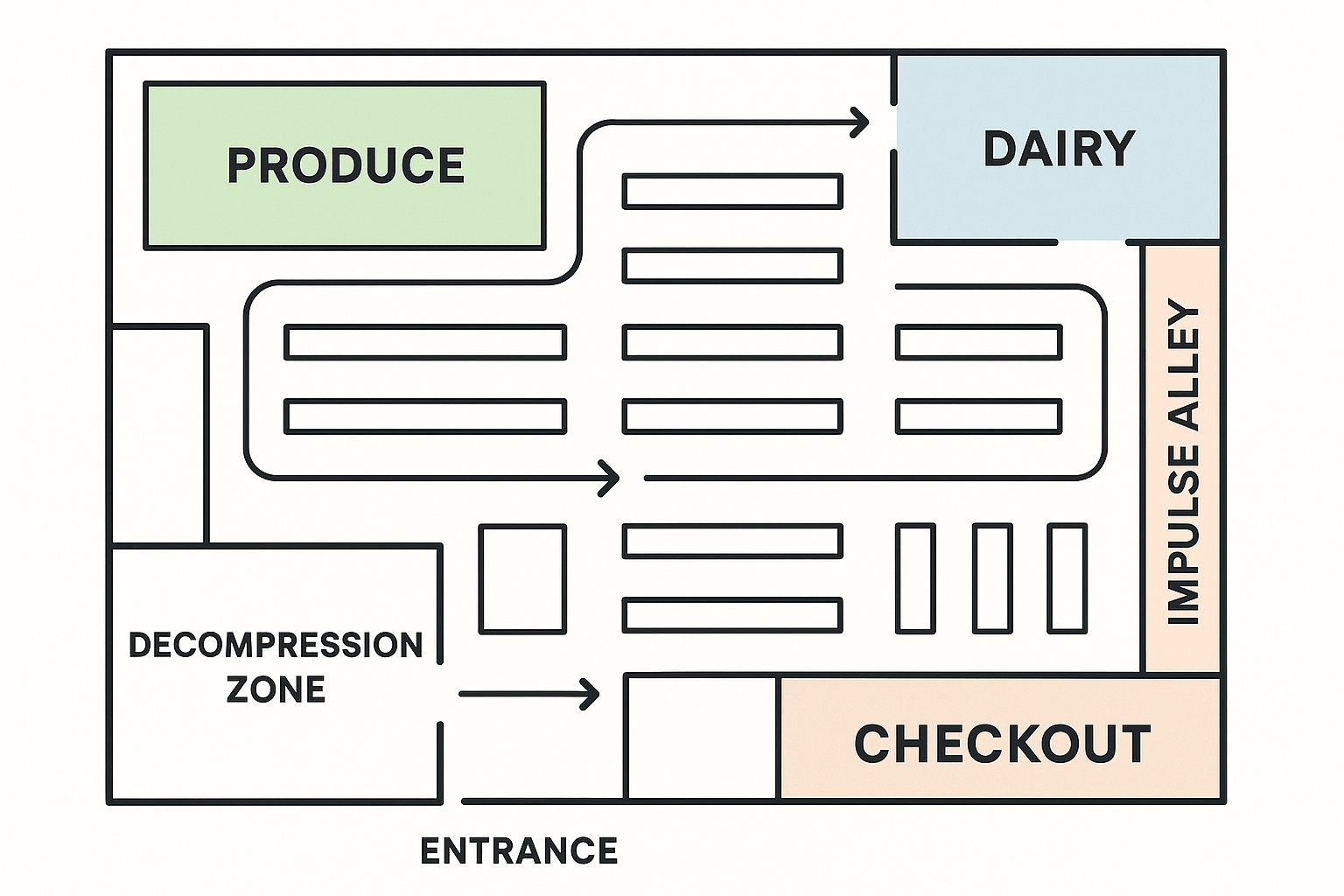The Decompression Zone and the Coastal Racetrack
Your geographical journey begins the moment you pass through the automatic doors. You don’t immediately plunge into narrow aisles. Instead, you enter what retail designers call the “decompression zone.” This open, transitional space, usually filled with a vibrant display of fresh flowers or seasonal produce, acts like a town square or a scenic overlook. Its purpose is to slow you down, allowing you to adjust from the chaotic geography of the outside world (the car park) to the carefully curated environment of the store. The bright colors and fresh scents of the produce section are placed here deliberately, creating a positive, healthy first impression that can influence the tone of your entire shopping trip.
From here, you are encouraged onto the “racetrack”—the wide main artery that runs along the store’s perimeter. In geographical terms, this is the coastline. It’s where you’ll find the highest-demand destinations: the bakery, the butcher’s counter, the deli, and the produce you just passed. By placing these popular “ports of call” along the outer edge, retailers force the majority of shoppers to travel the longest possible path around the store’s borders. This maximizes your exposure to other departments and increases the potential for unplanned “discoveries” along the way.
The Long Migration: A Quest for the Hinterlands
One of the most fundamental principles of supermarket geography is the placement of essential, high-frequency items. Where is the milk? The eggs? The bread? Almost without fail, they are located in the “hinterlands”—the most remote corners of the store. Milk, the single most common destination item, is the ultimate prize hidden at the end of the map.
This is a deliberate manipulation of what urban planners call desire lines—the paths people would naturally take between an origin and a destination. Your desire line is a straight shot to the dairy cooler. The store’s design, however, forces you on a long, winding migration deep into its territory. To complete your quest for milk, you must journey past thousands of other products. You are forced to traverse entire continents of cereal, archipelagos of canned goods, and valleys of pasta sauce. Each aisle you pass is a new region tempting you with its local wares, dramatically increasing the odds that you’ll succumb to an impulse buy.
Navigating the Canyons and the Gruen Transfer
The interior of the store is its own unique topography. The aisles are the supermarket’s “canyons.” They are intentionally long, narrow, and typically lack many cross-routes. This “canyon effect” discourages shoppers from easily cutting through to their destination. Once you commit to entering an aisle, you are more likely to travel its entire length to the end before turning, ensuring you see every product lining its walls.
This carefully controlled environment is designed to induce a psychological phenomenon known as the Gruen Transfer. Named after architect Victor Gruen, who designed the first modern shopping mall, it describes the moment when the store’s overwhelming sensory landscape (the lights, the music, the sheer volume of choices) overrides a shopper’s original mission. Your rational, list-driven brain switches off, and you begin to wander in a more suggestible, impulse-driven state. The canyon-like aisles and the long trek for essentials are key tools in triggering this profitable state of confusion.
The Vertical Geography of the Shelf
The store’s map isn’t just horizontal; it’s also vertical. The topography of the shelves is just as strategic as the floor plan. Think of shelf height as elevation, with the most valuable real estate located at a specific altitude.
- The Summit (Top Shelf): This “high elevation” zone is often reserved for smaller, niche brands, local products, or bulk items. It requires effort to reach, so only determined shoppers venture here.
- The Bull’s-Eye Zone (Eye Level): This is prime real estate. “Eye-level is buy-level” is the industry mantra. The most profitable products and leading national brands are placed here, where they are most likely to be seen and grabbed without a second thought.
- The Kid’s-Eye-View (Lower Shelves): This landscape is designed for a different demographic. Here, at the eye-level of a child in a shopping cart, you’ll find the sugary cereals, cartoon-branded snacks, and other items designed to spark a “pester power” negotiation between parent and child.
- The Bedrock (Bottom Shelf): The lowest elevation is for store brands, generic versions, and oversized, heavy items. These are often the best value, but the store makes you physically work for the savings by forcing you to bend down.
The Final Choke Point: The Checkout Border Crossing
Finally, your journey leads you to the checkout, the last and most potent geographical feature on the map. This area functions as a “border crossing” or a “choke point.” You are a captive audience, your movement restricted to a slow-moving queue. Your cart is full, your decision-making energy is depleted, and your willpower is at its lowest ebb.
This is the land of pure impulse. The checkout lanes are lined with high-margin, low-cost treats: candy, gum, magazines, cold sodas, and batteries. Retailers know this is their last chance to extract a few more dollars from your wallet. The placement is a calculated exploitation of human psychology at a specific, controlled geographical point. You’ve finished your long expedition, and now it’s time for a small, easy “reward.”
The next time you grab a shopping cart, remember that you’re not just a customer; you’re an explorer. You’re holding a map designed by some of the cleverest commercial geographers in the world. By understanding the coastline, the canyons, the hinterlands, and the choke points, you can begin to see the invisible forces at play. You can choose to follow their path or, with this newfound knowledge, confidently draw your own map.
